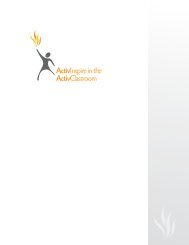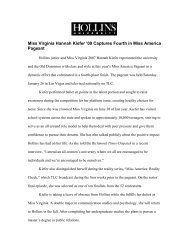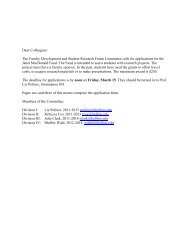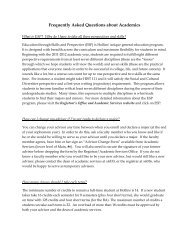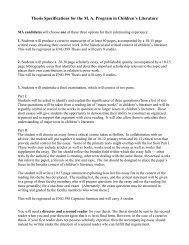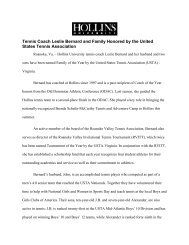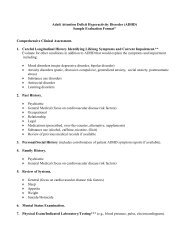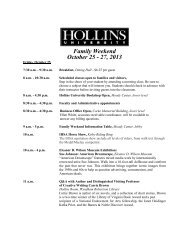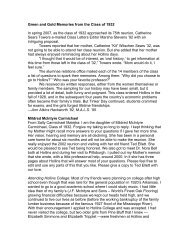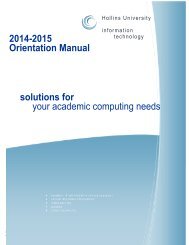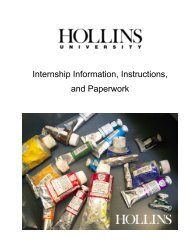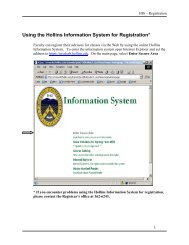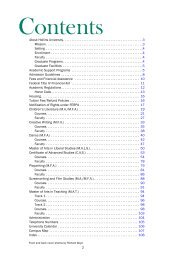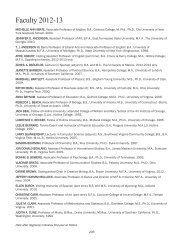ENGLISH & CREATIVE WRITING COURSE DESCRIPTIONS
ENGLISH & CREATIVE WRITING COURSE DESCRIPTIONS
ENGLISH & CREATIVE WRITING COURSE DESCRIPTIONS
Create successful ePaper yourself
Turn your PDF publications into a flip-book with our unique Google optimized e-Paper software.
sexuality; the scatological and the sublime; and inverted, monstrous, and diabolic bodies. We will be especially<br />
attentive to the connections between texts, genres, and corporeal forms. Prerequisite: sophomore standing or<br />
permission.<br />
ENG 330: 17TH‐ AND 18TH‐CENTURY LITERATURE (4)<br />
A survey of the aesthetic range of Restoration drama and its engagement with cultural transformations in<br />
England. Important Restoration adaptations of the genre include the appearance of women on the London<br />
stage, and the use of elaborate machinery as spectacle. Antecedent continental works and concurrent dramatic<br />
theory will be included. Prerequisite: sophomore standing.<br />
ENG 331: SHAKESPEARE’S ROME (4)<br />
Tudor historians linked the dim history of Britain to that of Rome. Republic, empire, myth—what did Rome, and<br />
romanitas, mean to Shakespeare? Influenced by Ovid and Plutarch as well as the British chronicle histories,<br />
Shakespeare located several tragedies in the Roman world and portrayed a Roman presence in Cymbeline. We<br />
will examine the political and aesthetic use of romanitas in select plays and The Rape of Lucrece. Prerequisite:<br />
sophomore standing or permission.<br />
ENG 332: SHAKESPEARE AND THE THEATRE (4)<br />
A consideration of the metaphor of the stage in representative comedies and tragedies. Prerequisite:<br />
sophomore standing.<br />
ENG 333: SHAKESPEARE’S WOMEN (4)<br />
An examination of the way female characters in Shakespeare’s comedies and tragedies perform, expand,<br />
subvert, or question their social roles. Attention will be given to Shakespeare’s creating and theatricalizing a<br />
female role, the political implications of dynastic marriage, female access to power through language and selfcreation,<br />
and women’s relationship to nature. Genre will also be a category of analysis. Prerequisite: junior<br />
standing or permission of instructor.<br />
ENG 334: THE “ATLANTIC” 18TH CENTURY (4)<br />
This course explores the circulation of ideas and identities through transatlantic pairings of literary,<br />
autobiographical, and philosophical writings. Special attention is given to the role of genre as its own conceptual<br />
and literal “geography.” Historical end points for the course: Aphra Behn’s Oroonoko (1688) and The Interesting<br />
Narrative of the Life of Olaudah Equiano (1789). Prerequisite: sophomore standing.<br />
ENG 335: MILTON (4)<br />
An analysis of Paradise Lost. We will use close readings of the poem’s language, structure, and themes to<br />
understand Milton’s epic as a literary masterpiece; we will consider literary responses to the poem as a means<br />
of determining the epic’s cultural significance. Prerequisite: sophomore standing.<br />
ENG 336: SHAKESPEARE’S TRAGEDIES (4)<br />
This course examines the structure and theme of tragedy in Shakespeare’s plays. Works to be read include<br />
Hamlet, Macbeth, Othello, King Lear, and Anthony and Cleopatra. Prerequisite: junior standing.<br />
ENG 337: 17TH‐CENTURY POETRY (4)<br />
The metaphysical poets: Donne, Herbert, Vaughan, Marvell. Emphasis on the emblematic imagination.<br />
Prerequisite: sophomore standing.<br />
ENG 338: MINORITY IMAGES IN CHILDREN’S LITERATURE (4)<br />
This course will explore the most significant concerns and questions regarding the imagining of American<br />
minority groups in picture books and novels for children and young adults. Emphasis will be placed on the



